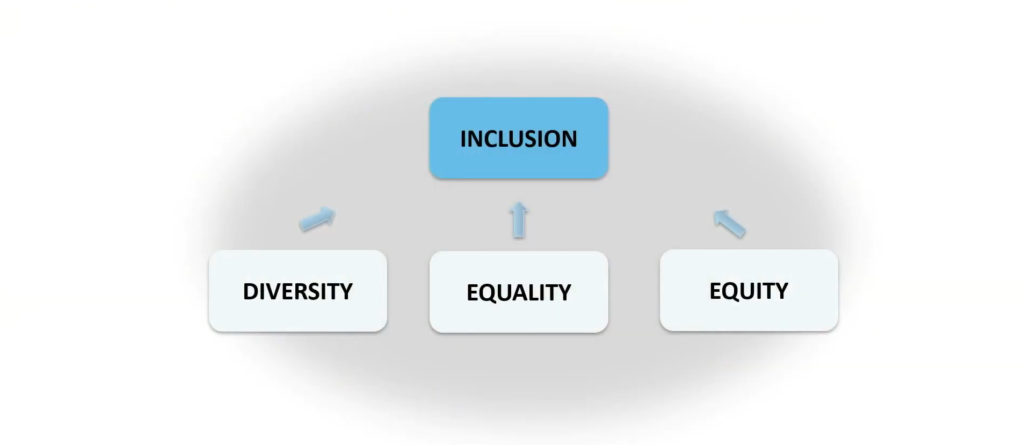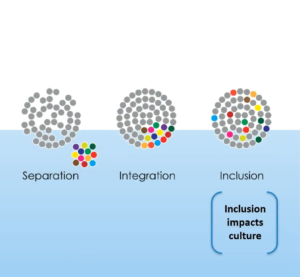
To achieve a healthy workplace culture, organizations must commit to fostering an inclusive environment that makes every employee feel seen, heard, and included.
Recently, the business community has been talking a lot about diversity, inclusion, equality, and equity – but what do these terms mean? Bridget Hurd, senior vice president of inclusion and diversity at Blue Cross Blue Shield of Michigan, spoke about the future of inclusive workplaces at the 2021 Detroit Policy Conference at the Aretha Franklin Amphitheater.
“When we talk about diversity in the workplace, it’s about recognizing the mix that each and every one brings to the environment,” said Hurd.
- Diversity: The traits and characteristics that make people unique. Diversity representation is an aspect of this.
- Inclusion: The behaviors and social norms the ensure people feel welcome and a sense of belonging in our workplace communities.
- Equality: Being valued equally for contributions and unique thoughts in the workplace.
- Equity: Equal opportunities and support to succeed and grow.
Hurd encourages businesses to rethink the diversity and inclusion continuum, with inclusion being the overarching goal.

“If we are doing diversity right, we are going to get to inclusion. If we are doing equality right, we are going to get to inclusion. If we are doing equity right – removing those barriers and obstacles, we are going to get to inclusion,” explained Hurd.
Diversity goes beyond race and gender
Typically, when an employer thinks about the term ‘diversity’, race, gender, ethnicity, and age likely come to mind. When you dig deeper into what diversity truly means, there is so much that lies beneath the surface. The iceberg model below illustrates the vast array of characteristics that contribute to diversity representation but are often overlooked – sexual orientation, socio-economic status, thinking styles, values, parental status, physical abilities, military experience – to name a few.

When employees come into work, they bring diverse experiences and that have influenced who they are and how they interact with others. That is why the many layers of diversity representation are the foundation for fostering an inclusive workplace.
The journey from separation to inclusion
The first step in this journey is understanding that different perspectives are crucial for reaching inclusion in the workplace.
“When we get to that true place of inclusion, that is where the magic is,” explained Hurd, “That is our opportunity to open our hearts, to open our minds, and recognize our similarities and our differences.”
Strategies for employers
Achieving an inclusive workplace takes more than updating internal policies and programs. Leadership specifically, plays an important role in helping employees feel included. In fact, what leaders say and do makes a 70% difference as to whether an employee feels included, according to Harvard Business Review.
There are several steps employers can take today to improve inclusion efforts in their workplace:
- Enroll managers in mandatory unconscious bias training. Ensure leadership understands what unconscious bias is, how it impacts workplace culture, and strategies for reducing it.
- Create an inclusion council of leaders who are passionate about inclusion in the workplace. The council should be involved in hiring goals, retaining and advancing a diverse workforce, and addressing potential employee engagement issues among underrepresented employee groups, says the Society for Human Resource Management.
- Celebrate differences. Invite employees to share their background and experiences to show you are passionate about celebrating their unique experiences.
- Listen to employees. Make it a habit at your organization to send out surveys and assessments to hear employee feedback about current inclusion efforts.
- Get creative. Fostering an inclusive workplace can be a fun journey. Get creative with your efforts – host a potluck to celebrate diverse employee cultures or organize a book club to widen employee perspectives around diverse experiences.
Cultivating an inclusive workplace takes time, empathy, and compassion. Businesses are responsible for creating an environment where employees feel comfortable bringing their whole self to work, in a space that celebrates everyone’s unique experience.